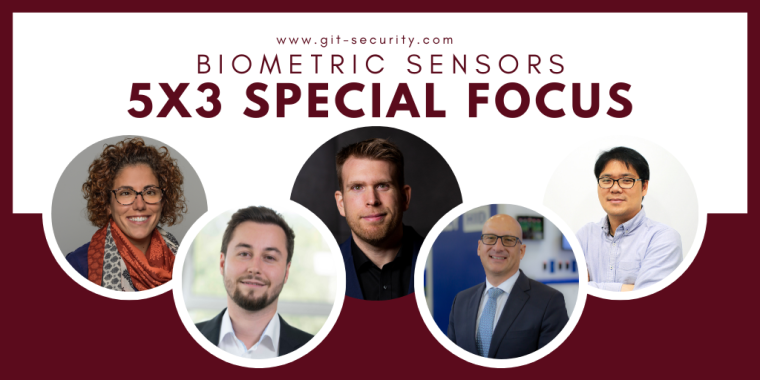Three Questions for Five Experts: Biometric Sensors
In this series, GIT SECURITY EMEA ask three questions to five industry experts about the issue's special focus. This time we asked five experts for their view on biometric sensors.

1. What type of biometric sensors do you recommend for access control applications?
2. What do you see as the biggest challenge in the use of biometric sensors and how do you approach this challenge?
3. Please describe one highlight of your product offering with the best performance for biometric access control?
Jaroslav Barton, Director Product Marketing, Physical Access Control, HID Global:
1. Contact-based fingerprint readers have extremely high accuracy so we recommend these for access control. Today’s modern fingerprint authentication solutions deliver a unique combination of ease of use, availability and convenience and higher security to physical access control systems. With improvements in liveness detection, system architectures, performance and ability to be easily incorporated into access control solutions, they seamlessly combine security and convenience to make them a viable option when accessing a facility, networks and services.
2. The global pandemic has dramatically increased interest in contactless technologies, but the challenge is the expense, suitability and accuracy of contactless biometrics. Contactless scanners or facial recognition don’t have the accuracy of contact-based fingerprint readers. And even in situations where authentication doesn’t involve touch, the next steps almost always do: opening a door, handling a phone, keyboard or mouse. Our approach is that it is far better and safer to have more secure authentication combined with smarter hygiene practices, such as routine disinfection of devices and hand sanitisers. That way we can keep people secure and safe.
3. The iClass SE RB25F fingerprint reader is a highlight in HID Global’s extensive line of biometric solutions for physical access control. Designed for two-factor authentication using fingerprint and/or high frequency credentials, the iClass SE RB25F offers superior performance, with mullion mount capabilities and Seos support for securing high value doors. Built for extensibility in demanding applications, the iClass SE RB25F supports a broad array of high frequency credential technologies and comes standard with HID Mobile Access and OSDP.
Soeren Wendland, Regional Sales Director for Central Europe, Idemia:
1. Idemia’s classical OEM fingerprint touch sensors and SIGMA range of terminals are highly developed, capture a larger area of the fingerprint, have anti-spoofing integrations, and BSI certificates. However, nowadays contactless biometric solutions are of high interest. Our 3D fingerprint sensor integrated in the MorphoWave allows contactless reading of up to four fingers in a single hand wave motion. Also, combining 2D, IR, and 3D sensors allows our facial recognition terminal VisionPass to provide a secure, user-friendly, and contactless experience. Especially in lobby areas where a high throughput is required, contactless solutions ensure a secure, fast, and convenient user experience.
2. Concerns about GDPR are slowing down adoption and may raise some concerns. We assist and advise our customers in the process of drafting required “Privacy Impact Assessment” and “consent of users / a legitimate interest” documents. More importantly, we have designed our terminals with ‘Privacy by design & by default’ principles as required by GDPR regulation. For example, fingerprint or face images are not stored, and no reverse engineering attempts on encrypted templates are possible. Users explicitly gesture to show intention to use the devices and all the personal user data is hosted and controlled only by the end-customer. The “right to be forgotten or consent withdrawal” for a user can also be performed easily.
3. The MorphoWave is a truly unique product. It works by simply waving your hand over the sensor where up to four fingerprints are scanned in a single hand movement. Acquisition of the fingerprint is dynamic, high-speed, and 100% touchless. This is very hygienic. The sensor uses a richer image with about 30% more area than conventional contact sensors which results in higher accuracy. The MorphoWave delivers high throughput and is neither affected by light or dust nor by wet, dry, dirty fingers or damaged fingerprints. With Ethernet, WiFi, Wiegand, OSDP, RS485, RS422 or Clock Data it can be easily integrated in any access control architecture.
Stefan Erber, Product Manager Hardware and Biometrics, PCS Systemtechnik:
1. We recommend palm vein recognition sensors. Our palm vein sensor operates completely touchless which is especially important in today’s hygiene sensitive environments. Its False Acceptance Rate of only 0,00008% with a False Rejection Rate of 0,01% guarantees reliable usage in all areas be it comfort or high security applications. Our sensor can be adjusted for different exposures to light and thus be operated in outside areas as well as indoor areas.
2. In Europe regulations regarding the GDPR are a challenging task for companies wanting to introduce biometric access control to their facilities. Biometric data for individuals is considered sensitive personally identifiable information, and as such it requires a higher level of protection. Usually, an individual’s explicit consent is required to operate biometric access control systems. With our TemplateOnCard technology biometric templates are not stored in databases but instead on the user card only. During the authentication process the device verifies the presented template. This way control over the biometric data is always in the hands of the user, which is often an important fact for employees.
3. Our Intus PalmSecure solution combines outstanding security and ease of use. It is suitable for numerous use cases be it high security or comfort application, indoor or outdoor. With our latest product relaunch, we implemented an optimized setting for areas with high light exposure to provide reliable authentication results even in outdoor areas – a field where other optical based systems often tend to have issues. Furthermore, we optimized authentication times to be as low as 0,5 seconds.
Seongbin Choi, Head of Suprema R&D Center, Suprema Inc.:
1. Fingerprint recognition is a stable technology that has been tested and improved for decades and will continue to be used, but since the outbreak of Covid-19, the demand for contactless biometrics increased and for this growing demand, we recommend facial recognition.
2. The biggest challenge – or ‘change’ – in biometric recognition technology comes from the advancement of deep learning AI and visual-based face recognition. Before deep learning, we had to choose the features in data (face images) to train the AI and the AI was trained with relatively limited amount of data acquired on the biometric recognition devices. But now with deep learning, AI is able to extract the features on its own and all we need is a huge amount of correctly labelled data, not necessarily from the biometric devices, to feed the AI. Suprema has a team dedicated to developing AI-based biometric technology, striving to further enhance the accuracy of its algorithm.
3. Suprema’s latest face recognition terminal FaceStation F2 provides exceptional authentication results by utilizing both visual and IR face recognition. While other facial recognition technology uses IR recognition only for anti-spoofing purposes, Suprema FaceStation F2 uses both IR and visual recognition to capture face photo, generate templates and perform matching of templates. We have named the technology ‘fusion matching’ as it yields the best matching results by optimizing IR and visual matching scores and balancing them alongside environmental factors such as the intensity of illumination.
Natalia Román, Chief Marketing Officer at Touchless Biometric Systems:
1. There is no one-size-fits-all biometric sensor for access control applications. The TBS approach is to tailor the ideal solution to the needs of our customers in terms of environment, performance, and security – among others. For instance, the perfect access control solution for a high throughput environment such an airport might differ from the most suited setup for a governmental data center. The key technologies enabling biometrics access control are 3D touchless fingerprint scan and iris recognition.
2. Holistic end-to-end security. From integration, to enrollment, identification, verification, and data management. When a secure biometric solution is in place, security becomes ‘invisible’. However, the consequences of a breach in security are painfully tangible and quickly cascade. TBS focuses on prevention, that is, designing bullet-proof biometric sensors & solutions. Access control applications demand flexibility (outdoors/indoors, integration, automation) without compromising on performance or security.
3. From a security standpoint, TBS flagship, the 3D Terminal, is the go-to solution. The three-dimensional and contact-free fingerprint scan terminal provides highest security, recognition performance and multifunctionality. Seamless security is achieved thanks to live detection, multi-level data encryption, template on card, and anti-tampering. Unlike other technologies, 3D fingerprint scan delivers the highest accuracy – also referred as ‘true identity’.














